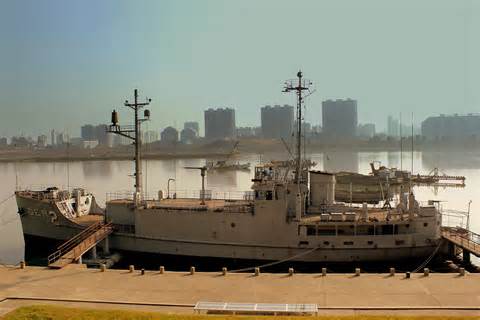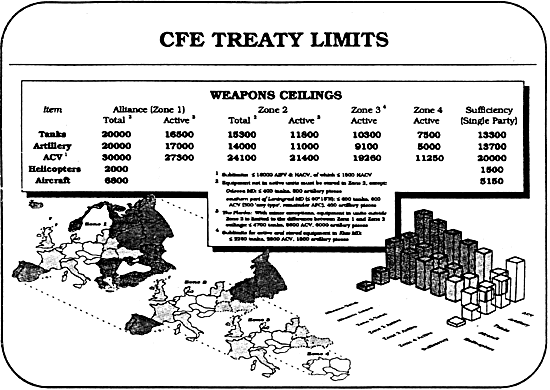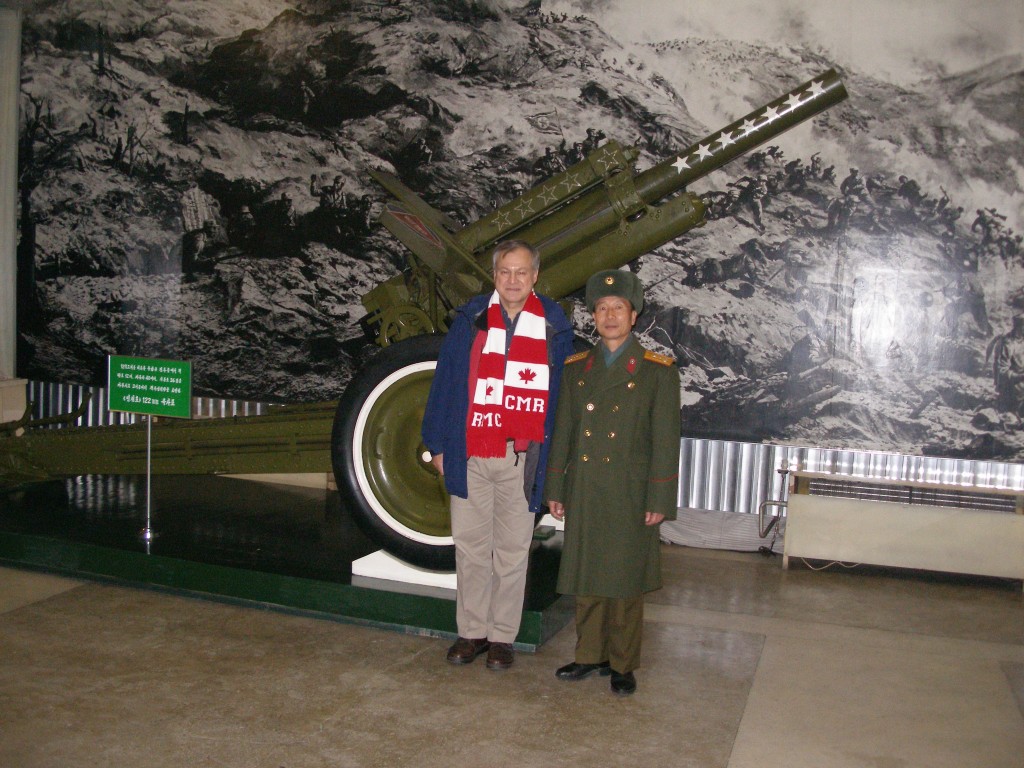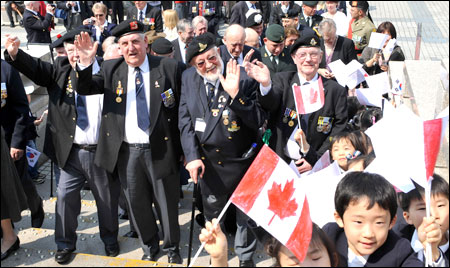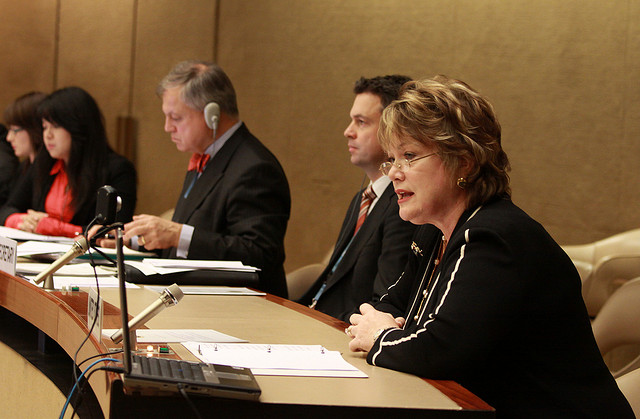
Steph Ochej discovers 8816 Marius Grinius is much more than a gentleman of leisure
By: Steph Ochej
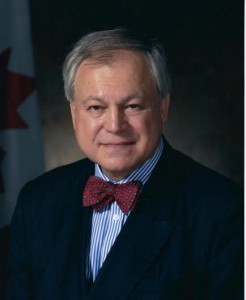 Marius Grinius was born in Cochrane, Ontario. His parents were WWII refugees from Lithuania who were living in Moose River Crossing—a small Ontario town on James Bay—at the time that he was born. Eventually, the family moved to Hamilton where Grinius grew up and graduated from high school. When it came time for the first-generation Canadian to decide what he wanted to do after he graduated, he was torn between becoming a doctor and joining the military. “In actual fact, I had won scholarships to pre-med at Queen’s and a few other places, and at the same time had been accepted to go to RMC. My final thinking was that medicine was too serious of a vocation and I was much more attracted to the military and to RMC.” So, a young Marius enrolled at RMC in 1967.
Marius Grinius was born in Cochrane, Ontario. His parents were WWII refugees from Lithuania who were living in Moose River Crossing—a small Ontario town on James Bay—at the time that he was born. Eventually, the family moved to Hamilton where Grinius grew up and graduated from high school. When it came time for the first-generation Canadian to decide what he wanted to do after he graduated, he was torn between becoming a doctor and joining the military. “In actual fact, I had won scholarships to pre-med at Queen’s and a few other places, and at the same time had been accepted to go to RMC. My final thinking was that medicine was too serious of a vocation and I was much more attracted to the military and to RMC.” So, a young Marius enrolled at RMC in 1967.
More
While at RMC, the Ontario native played on the senior varsity football team, eventually making it to the all-star team. He also competed on the school’s judo team, and in 1968 won an OSLAA Inter-Collegiate judo championship. In his third year, Grinius became co-editor of RMC’s student newspaper—The Marker. The paper covered the usual—school activities, interviews with staff, cartoons, and then what the former co-editor refers to as “fairly serious, reflective articles on things like society in general at that time.” Given that he went to very disciplined, traditional RMC in the late 1960s, there was a huge cultural gap between the lives of military college cadets compared to other people of their age. “A totally different kind of student culture—long hair, drugs, sex, and rock n’ roll, and of course, the cadets were living through a somewhat different regime that included a heck of a lot more self-discipline,” he explains.
In addition to working hard at RMC, Grinius did his fair share of playing hard. For instance, one West Point Weekend happened to fall right after the USS Pueblo had been captured by the North Koreans for spying in North Korean waters. As a way to welcome the West Point cadets, several of the RMC cadets went down to an old boat docked off the causeway and painted “USS Pueblo” on the side of it. The joke took on a whole new meaning 30+ years later when Grinius, at the time Ambassador to North Korea, visited the real USS Pueblo in Pyongyang.
Another one of his fond memories from his time spent at RMC came in the ex-cadet’s first year. One day the freshman and some of his fellow classmates took one of their favourite seniors to throw in Lake Ontario for his birthday, as per tradition. Unfortunately for the beloved senior, his birthday fell in January. “We had him tied up to his chair…and we had to try to break the ice in order to dump him, but the ice was too thick,” Grinius recalls fondly. Luckily for the senior, the young cadets gave up trying to break through to freezing Lake Ontario, and ended up tossing him into the swimming pool—a much warmer alternative.
When he graduated in 1971, having been Cadet Wing Commander, Grinius was awarded The Sword of Honour as the best all-around cadet in the graduating year. After that he left straight for Valcartier as an artillery officer for the 5ième Régiment d’artillerie légère du Canada (5RALC). While in Valcartier the young officer really enjoyed the regimental camaraderie of being part of 5RALC, and took advantage of being so close to beautiful Québec City. He and his battery even had the opportunity to travel to Baffin Island in the middle of winter to do Arctic warfare training.
In 1974, he left for the UK for the long gunnery staff course in air defence at the Royal Artillery School (RSA) in Larkhill. During that time, Grinius was lucky enough to go on deployment to places like Wales and the Outer Hebrides off the coast of Scotland. After finishing his year in the UK, he headed back home to Canada to be an instructor at the Combat Arms School in Gagetown. In the summer of 1978, he was sent overseas once again to Lahr, West Germany as a staff officer at Headquarters Canadian Forces Europe (HQ CFE).
The former artillery officer’s time in Germany was served under General Charles H. Belzile, whom Grinius describes as “a wonderful guy…who was one of these guys who could eat Soviet T72 tanks for breakfast.” His brigade—the 4th Canadian Mechanized Brigade Group (4CMBG)—was what he calls the “strategic reserve,” meaning they were there to support a German corps and an American corps. “We spent a lot of time making sure that we had all of our stuff together from an operational and logistics point of view, to make sure that whatever happened we would be ready,” he says.
While in Germany, he also had the opportunity to participate as an umpire in REFORGER—Return of Forces to Germany—which was an annual exercise conducted by NATO during the Cold War. The exercise was designed to give NATO the ability to quickly deploy troops in West Germany in case of a conflict with members of the Warsaw Pact. “That meant flying over American, Canadian air forces and stuff like that. We’d do all kinds of battle manoeuvres, so [it was] a lot of fun!” Grinius recalls.
Of his time spent in Germany, he adds: “One thing that for me was really heartwarming was the fact that all of us—when we were in the field—wore our uniforms with the Canadian flag patches on our shoulders, and the welcome that ordinary German people had for us was really quite incredible. It was a nice, good feeling, and a feeling of contributing, let’s put it that way.”
At the end of his time in Germany, the expatriate made the decision to pursue a career in the foreign service. “One Friday evening after happy hour at the Lahr Officers’ Mess I motored up to Bonn and Saturday morning wrote my foreign service exam, which was…I don’t know how I passed it,” he chuckles. He then had a follow-up interview in Paris after almost missing the reply-by deadline because he had been on exercise. It was almost at the end of his time in staff college in Kingston that Grinius heard he had made it in. “Though things were very positive career-wise in the military, this kind of opportunity to do something different wouldn’t come around again [I decided], so I accepted. 6-7 months later I was in Thailand in my first refugee camp,” he adds.
On the transition from the military to the foreign service, the newly appointed foreign service officer found things similar in several ways. “First of all, both the foreign service and the military tend to be conservative structures and cultures… Secondly, I could always say that I went from one hierarchy to another,” he explains. “I used to joke that even the foreign service had their own uniform: three-piece pinstripe suits,” he says. “Although, I didn’t get to wear one until I got to Brussels much later. My uniform in the refugee camps was a little bit more relaxed.”
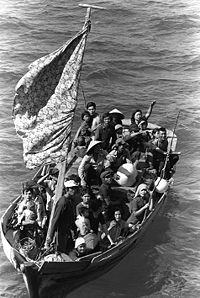 What was very different from his time in the Forces, however, was dealing with the Indochina refugee crisis. “In 1979, going into 1980, this was the height of the boat people flood out of Indochina,” he explains. “For the first two years I was in every refugee camp that existed in Thailand…selecting Vietnamese, Lao, and Cambodian refugees for settlement to Canada,” he explains. After that, what was supposed to be only a two-year posting got extended twice more. First, he did consular and public affairs work which he describes as helping “Canadians who had gotten into trouble.” “And I had some real doozies, let’s put it that way!” he laughs. “It’s not every day you can stop a 747 from taking off, and it’s not every day that one can commandeer a helicopter to save somebody’s life on a little island in the Gulf of Siam.”
What was very different from his time in the Forces, however, was dealing with the Indochina refugee crisis. “In 1979, going into 1980, this was the height of the boat people flood out of Indochina,” he explains. “For the first two years I was in every refugee camp that existed in Thailand…selecting Vietnamese, Lao, and Cambodian refugees for settlement to Canada,” he explains. After that, what was supposed to be only a two-year posting got extended twice more. First, he did consular and public affairs work which he describes as helping “Canadians who had gotten into trouble.” “And I had some real doozies, let’s put it that way!” he laughs. “It’s not every day you can stop a 747 from taking off, and it’s not every day that one can commandeer a helicopter to save somebody’s life on a little island in the Gulf of Siam.”
And the stories only get more interesting from there: Because Vietnam had invaded Cambodia, he was put on the duty of watching the border just to observe what was going on. The small-town Canadian boy had some once in a lifetime experiences, such as having lunch in the jungle with Ieng Sary—third in line of the Khmers Rouges behind Pol Pot; spending time with the ex-Premier of Cambodia, Son Sann and the Khmer People’s National Liberation Front; meeting with the Sihanoukist MOULINAKA; and accidentally wandering through a minefield (“I was going to return the same way [I came] and they said, “Don’t go that way! That’s a minefield!””). He was also made the point person to look into the allegations of the use of chemical and biological weapons in the area, a project which he worked on with a former RMC classmate, 8657 Jamie Dow, among other people.
After having more adventures in three years than most people experience in a lifetime, Grinius returned to Ottawa where he worked as the desk officer for Nuclear Arms Control, which he describes as “a bit of culture shock in reverse.” Through this job, he was able to travel to the United Nations in New York City as well as Geneva for some of the discussions on nuclear weapons and the Cold War. Then, in 1986, he was assigned to the Canadian Delegation to NATO in Brussels, during what was one of the most interesting times in the Cold War—the end of it.
“It was fascinating to be there,” he says. “NATO was getting ready to negotiate the Conventional Forces in Europe Treaty (CFE Treaty)…so I was involved with pretty well every aspect that touched that treaty,” he explains further. “Because of my military background, DND was happy to have me represent them at various meetings, and they were numerous—hundreds of such meetings… It was a heck of a lot of fun, and a real adventure and privilege,” he adds.
Next, Grinius volunteered to open Canada’s embassy in Hanoi, Vietnam. This led him back to Bangkok in 1990 where he travelled back and forth between the two cities for about a year trying to find a suitable office for the future embassy, find a residence, and hiring Vietnamese staff.
In 1991, the Chargé d’Affaires made the move to Hanoi in what he refers to as “one of the toughest things I’ve ever done, just because of the nature of the regime.” Their telephones were bugged, they needed permission to travel outside of a very small area in town, and their Vietnamese staff had to report to the Ministry of the Interior once a week to inform on what was happening at the embassy. “But because it was such a challenge it was also one of the most satisfying things I did,” he adds.
From 1993 to 1997, he was back in Ottawa as the Director of the Asia Pacific South Relations Division, and then after a restructuring, the Director of the Southeast Asia Division. Then, in 1997, he returned to the embassy he had set up in Hanoi, Vietnam, years before but this time as ambassador. He remained there until 1999—having hosted Prime Minister Jean Chrétien and Quebec Premier Lucien Bouchard for the Sommet de la Francophonie held in Hanoi in late 1997—and then returned to Ottawa once again, having been accepted in the Accelerated Executive Development Program.
This led to Grinius working for the Privy Council Office on social policy in immigration law, then aboriginal policy. Next came a stint in Western Economic Diversification. Then it was back to PCO in security and intelligence. “This was a coordinating role to make sure that the National Security Advisor to the Prime Minister…knows everything and can advise the Prime Minister accordingly. …I can’t say too much more about it,” he says, adding an air of mystery to an already fascinating career. “Definitely operational, by the way—spies and everything. But the way that I would describe it to people was, it’s like Lord of the Rings when Frodo puts the ring on, and the world suddenly gets really wonky,” he quips.
In 2004, “out of the blue,” he got a call from DFAIT asking him if he’d like to be Ambassador to South Korea. By then, he was already married to his wife Carolyn who was working for CIDA at the time. Carolyn had spent some time in Thailand when she was completing her MBA and later had lived in Vietnam. It didn’t take long for the couple to agree that he should take the position. “Going to Korea was like coming home again,” he says nostalgically.
One of his favourite parts about being Ambassador to South Korea was annually hosting Korean War veterans. “It was just such a privilege,” he says. “What I would do was have a reception for the veterans at the Canadian official residence with lots to drink, and we’d have a piper—we did it up well!” he adds. During their visit, Grinius would accompany the veterans up to the Korean Demilitarized Zone, where he’d get some really interesting stories out of the vets. “One veteran —2981 Monte Moffat—is a gunner… We’re at the Demilitarized Zone, we’re…where the barbed wire fence is, and he said to me, “Do you see that hill over there? That was my OP—my observation post. And you see across that valley where the wood line is? That’s where the Chinese were. And you see to the right? That’s where the North Koreans were!” Just to listen to them!”
While he was Ambassador to South Korea, Canadian accreditation for North Korea was transferred from Beijing to Seoul, and Grinius became Ambassador to North Korea as well.
He did have the opportunity to visit four times, and calls it the scariest place he’s ever visited.
Following Korea, there was some disagreement as to where he would end up next. “[DFAIT said] “You’re coming home!” So, of course, I ended up in Geneva,” he laughs.
From 2007-2011 he was Ambassador and Permanent Representative to the Office of the United Nations and to the UN Conference on Disarmament. He spent most of his time working with the Human Rights Council (on which Canada was vice president at the time), the World Health Organization, the High Commissioner for Refugees, and the International Labor Organization, among other organisations and groups. While in Geneva, he had the privilege of working alongside other accomplished people such as Margaret Chan of WHO, former Portuguese Prime Minister António Guterres of UNHCR, and Louise Arbour, formerly of the Supreme Court of Canada.
In 2009 he was the Chair of the Biological Weapons Convention which allowed him to travel to Morocco, Kyrgyzstan, Russia, Kazakhstan, China, the UK, the US, among other places. “I was also in exotic Winnipeg! (laughs) And that was because we’ve got the biological lab there that’s world class,” he adds.
In 2011 Grinius again had the chance to work for DND, but this time as Director-General of International Security Policy. What he particularly enjoyed about that job was getting the chance to work with other ex-cadets again, such as 12320 Walter Natynczyk and 12192 Tom Lawson. “It was fun to renew the RMC connection again,” he says.
In November of 2012, he retired and became what he refers to as a “gentleman of leisure.” Though—one should note—his leisure includes being what he calls “the number one responder” in terms of his two sons, ages 11 and 13, with his wife Carolyn who is still working at DFATD. Additionally, he is frequently invited to give lectures and participate in conferences at various institutions because of his vast experience in terms of Asia and arms control. The week before this interview took place, for instance, he gave a lecture at the University of Toronto on the Cold War and nuclear strategies. He has also accepted a fellowship at the Canadian Defence and Foreign Affairs Institute, in addition to being on the Executive Committee of the RMC Club.
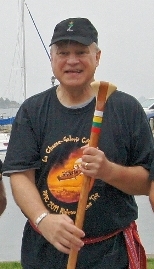 Though he has experienced and accomplished so much, Grinius still remains thankful for his RMC roots and humbled in all that he’s seen and done. “It’s that overall package from RMC that I’ve always been truly grateful about, in terms of education and experience,” he says. He also realises how lucky he has been to have done all of it: “I have to emphasize the privilege.
Though he has experienced and accomplished so much, Grinius still remains thankful for his RMC roots and humbled in all that he’s seen and done. “It’s that overall package from RMC that I’ve always been truly grateful about, in terms of education and experience,” he says. He also realises how lucky he has been to have done all of it: “I have to emphasize the privilege.
All of these sort of things, just being there and participating and contributing— it was always a privilege.” And—despite having visited some of the most exotic corners of the world— he still appreciates and gets excited about exploring right at home in Canada.
“We’re so lucky as Canadians in terms of what we have…we have to appreciate it,” he says earnestly.
Spoken like a man who has truly learned to value every moment life has to offer.


